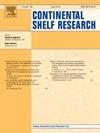两大“水坝”对支离破碎的长江中营养物质和有机质的逐步变化:一个看得见,一个看不见
IF 2.2
3区 地球科学
Q2 OCEANOGRAPHY
引用次数: 0
摘要
来自长江等大河的生物源元素的输运通量对河口和沿海环境起着至关重要的作用。然而,由于人类活动和自然因素的共同作用,导致了沿江生物成因要素的复杂时空变化。本研究在2021年和2022年的不同季节对长江进行了四次采样。结果表明:三峡库区出现了两个悬浮颗粒物(SPM)浓度快速上升的风暴区,分别位于三峡库区下游宜昌—岳阳和库区上游芜湖—徐留井之间。这两个泥沙淤积区起到了分隔长江干流的两个“坝”或“墙”的作用,形成了三峡库区(重庆—宜昌)和中下游(武汉—芜湖)两个泥沙淤积区。在这些SPM沉积带内,SPM浓度缓慢下降,颗粒有机碳在SPM中的比例增加。尽管人类活动不断地从河岸提供营养物质,但河水的蓄水作用阻碍了营养物质随河流流动的浓度增加。在SPM涌动带和SPM沉积带中,营养物和有机质的不同变化模式突出了它们的“阶梯式”分布特征。目前长江呈现出深水库特征,这种特征与其他人为活动共同驱动了长江水体养分和有机质的显著年代际变化趋势。本文章由计算机程序翻译,如有差异,请以英文原文为准。
Stepwise variations of nutrients and organic matter in the fragmented Changjiang River by two big “dams”: One visible and one invisible
The transport flux of biogenic elements from large rivers such as the Changjiang (Yangtze) River, played a critical role in determining the estuarine and coastal environments. However, the combined effects of human activities and natural factors had resulted in complex spatiotemporal variations of biogenic elements along the river. In this study, sampling was conducted on four campaigns through the Changjiang River in different seasons during 2021 and 2022. The results showed that two suspended particulate matter (SPM) Surge Zones with rapidly increased SPM concentrations emerged, one between Yichang and Yueyang, downstream of the Three Gorges Dam (TGD), and the other between Wuhu and Xuliujing, upstream of the estuarine area. The two SPM Surge Zones had acted as the two “dams” or “walls” that separated the Changjiang River mainstream and led to the formation of two SPM Deposition Zones, one in the Three Gorges Reservoir (between Chongqing and Yichang), and the other in the middle and lower reaches (between Wuhan and Wuhu). Within these SPM Deposition Zones, SPM concentrations slowly decreased, and the proportion of particulate organic carbon in SPM increased. This reservoirization of the river water hindered the concentration increase of nutrients with the river flow, despite their continuous supplies from river banks by anthropogenic activities. The different patterns of nutrients and organic matter variations in the SPM Surge Zones and in the SPM Deposition Zones highlighted a “stepwise” characteristic in their distribution. The Changjiang River showed a deeply reservoir-like characteristic at present, which, along with other anthropogenic activities, had also driven significant decadal trends of nutrients and organic matter in the river waters.
求助全文
通过发布文献求助,成功后即可免费获取论文全文。
去求助
来源期刊

Continental Shelf Research
地学-海洋学
CiteScore
4.30
自引率
4.30%
发文量
136
审稿时长
6.1 months
期刊介绍:
Continental Shelf Research publishes articles dealing with the biological, chemical, geological and physical oceanography of the shallow marine environment, from coastal and estuarine waters out to the shelf break. The continental shelf is a critical environment within the land-ocean continuum, and many processes, functions and problems in the continental shelf are driven by terrestrial inputs transported through the rivers and estuaries to the coastal and continental shelf areas. Manuscripts that deal with these topics must make a clear link to the continental shelf. Examples of research areas include:
Physical sedimentology and geomorphology
Geochemistry of the coastal ocean (inorganic and organic)
Marine environment and anthropogenic effects
Interaction of physical dynamics with natural and manmade shoreline features
Benthic, phytoplankton and zooplankton ecology
Coastal water and sediment quality, and ecosystem health
Benthic-pelagic coupling (physical and biogeochemical)
Interactions between physical dynamics (waves, currents, mixing, etc.) and biogeochemical cycles
Estuarine, coastal and shelf sea modelling and process studies.
 求助内容:
求助内容: 应助结果提醒方式:
应助结果提醒方式:


